Sigreturn Oriented Programming Attack
By Jiawei Wang
This is my Notes for This Paper : Framing
Signals — A Return to Portable Shellcode
Which
Won the Best Student
Paper in 35th IEEE Symposium on Security and Privacy. 2014
- 1.Return Oriented Programming Attack
- 2. Sigreturn Oriented Programming Attack
- 3. The Prevention of SROP Attack
1.Return Oriented Programming Attack
Ways Oprating System Defence
Data Execution Protection(DEP)
In computer security, executable-space protection marks memory regions as non-executable, such that an attempt to execute machine code in these regions will cause an exception.
Address Space Layout Randomization(ASLR)
Address space layout randomization (ASLR) is a computer security technique involved in preventing exploitation of memory corruption vulnerabilities. In order to prevent an attacker from reliably jumping to, for example, a particular exploited function in memory, ASLR randomly arranges the address space positions of key data areas of a process, including the base of the executable and the positions of the stack, heap and libraries.
Stack Destruction Detection(SDD)
Canary is a Test area in Stack. Which helps to avoid Stack
Overflow
Although The Stack Randomization(ASLR) Can
counter some forms of attack
Random loss to brute
force You will never know what the power of attacker
Let’s see a normal stack:
-------------------------------------
| |
|___________________________________| --> Caller's shallow frame
| Return address |
-------------------------------------
| |
| | --> Buffer
|___________________________________|
| Canary |
------------------------------------- --> buf = %rspStore a special Canary Value between any local buffer and the
Caller’s shallow frame
Let’s see an example to figure out that:
/*echo.c*/
#include <stdio.h>
void echo(){
char buf[8];
gets(buf);
puts(buf);
}After we compile it:
## echo.s
_echo: ## @echo
.cfi_startproc
## %bb.0:
pushq %rbp
movq %rsp, %rbp
.cfi_def_cfa_register %rbp
pushq %rbx
subq $24, %rsp
.cfi_offset %rbx, -24
movq ___stack_chk_guard@GOTPCREL(%rip), %rax
movq (%rax), %rax
movq %rax, -16(%rbp)
leaq -24(%rbp), %rbx
movq %rbx, %rdi
callq _gets
movq %rbx, %rdi
callq _puts
movq ___stack_chk_guard@GOTPCREL(%rip), %rax
movq (%rax), %rax
cmpq -16(%rbp), %rax
jne LBB0_2
## %bb.1:
addq $24, %rsp
popq %rbx
popq %rbp
retq
LBB0_2:
callq ___stack_chk_fail
## -- End function
We can find that in line 11 at echo.s:
movq stack_chk_guard@GOTPCREL(%rip), %rax
It is like we create a special position pointer and mov it to
%rax(This Special area is Marked as Read-Only)
In
the next line We move the value into %rax and this value is
Canary
Before the function puts() return. The gcc will
check the Value of Canary’s position whether it is as same as the Value
store in The Special position pointer(In Line 20)
If not equal(jne). Jump to LBB0_2(last line) and
cause stack_chk_fail
Return Oriented Programming Attack
Because of These Defences. The earliest code injection
attacks are basically unusable in current operating systems, ROP
appeared
The main idea of ROP is that the attacker does not need to
inject code himself (because the injected code is not executable under
the protection of DEP), but uses the existing code fragments of the
system to construct the attack. It is called ROP here because the way it
changes the control flow is to use the return instruction in the system
(such as ret in x86).
For Example:
Here is a simple example to illustrate how to use ROP to implement a memory assignment statement:
Mem[v2] = v1Which assembly code is:
mov %eax v1;
mov %ebx v2;
mov [%ebx], %eaxWe can achieve that Statement by using ROP:
-------------------------------------
| addr3 |
| v2 |
| addr2 | --> Stack
| v1 |
| addr1 |
--------------------------------------------------------------------------
addr1: pop %eax; ret |
addr2: pop %ebx; ret | --> Memory
addr3: mov [%ebx]; %eax; |
-------------------------------------Among them, addr1, addr2, and
addr3 are the memory addresses of the corresponding
instructions. We call each line a “gadget”. The same effect as the
compilation above can be achieved by constructing the data on the stack
as shown in the figure above.
Before trying to understand The Detail of ROP. We need to
understand the Core of ROP:
When ASLR and DEP are
turned on, the memory location of the program will change every time the
program is executed and the executable location cannot be written, and
the writeable location cannot be executed, so try to combine the
original fragments of the program to form a meaningful attack
process.
The small fragments of these programs are called gadgets,
such as pop eax; ret; fragments, these fragments mostly exist at the end
of the function (because there is ret), you can use tools to find
available gadgets
The Core of ROP
As we mentioned before: Because of ASLR and DEP. The Program
which is executable cannot be written, and the Program which is
writeable cannot be executed.
If The Attack wants
to run his attack program in a computer. The ROP attack need to modify
the writeable program(Stack) to control the executable
program(Code)
And the Only Way Link Between Stack and Code is
ret in x86
Procedure: *
First. The Attacker need to find a buffer overflow
loophole 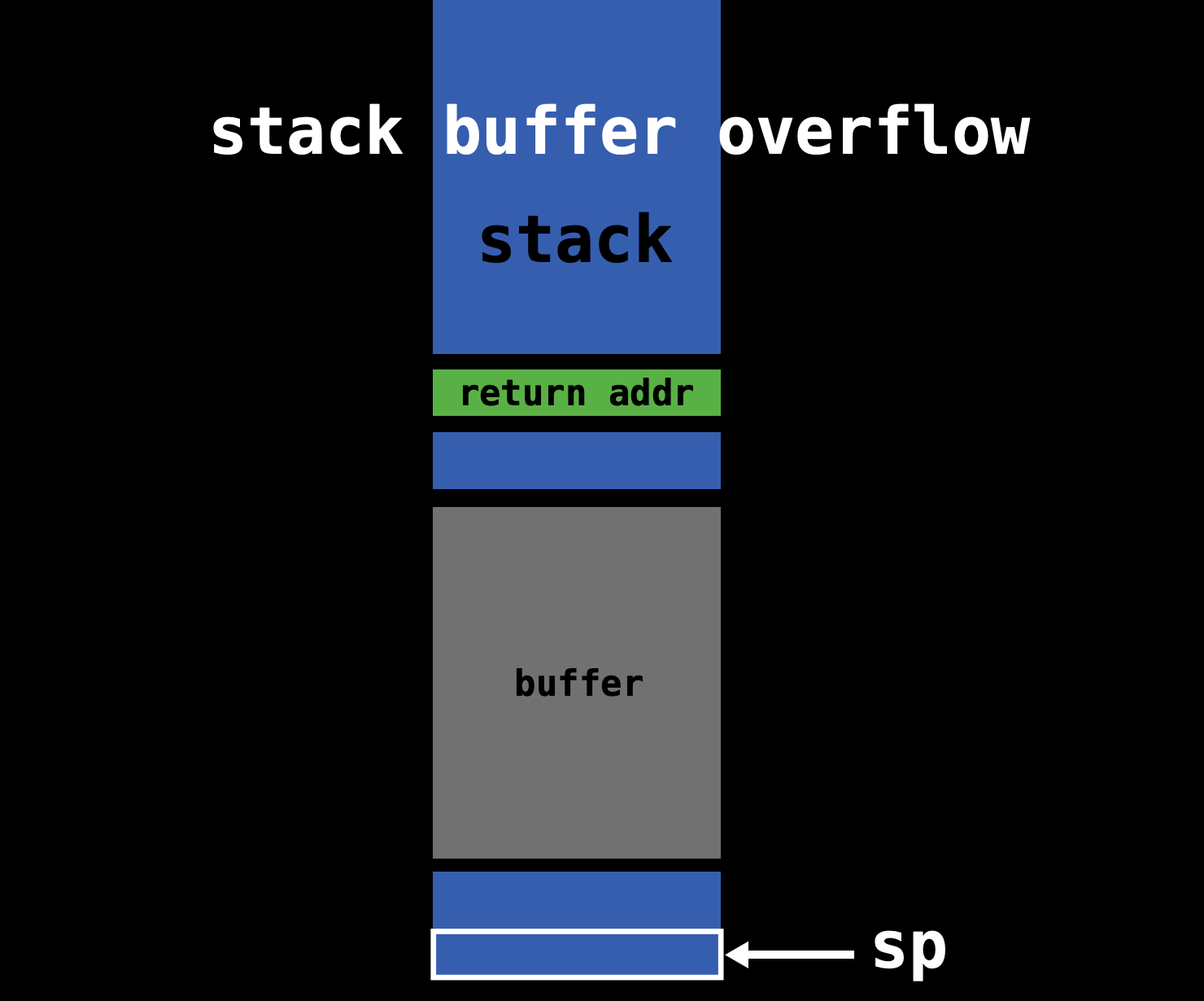
* Then. It is very important
and troublesome to distribute all gadgets in memory and stack
(One to
one correspondence)
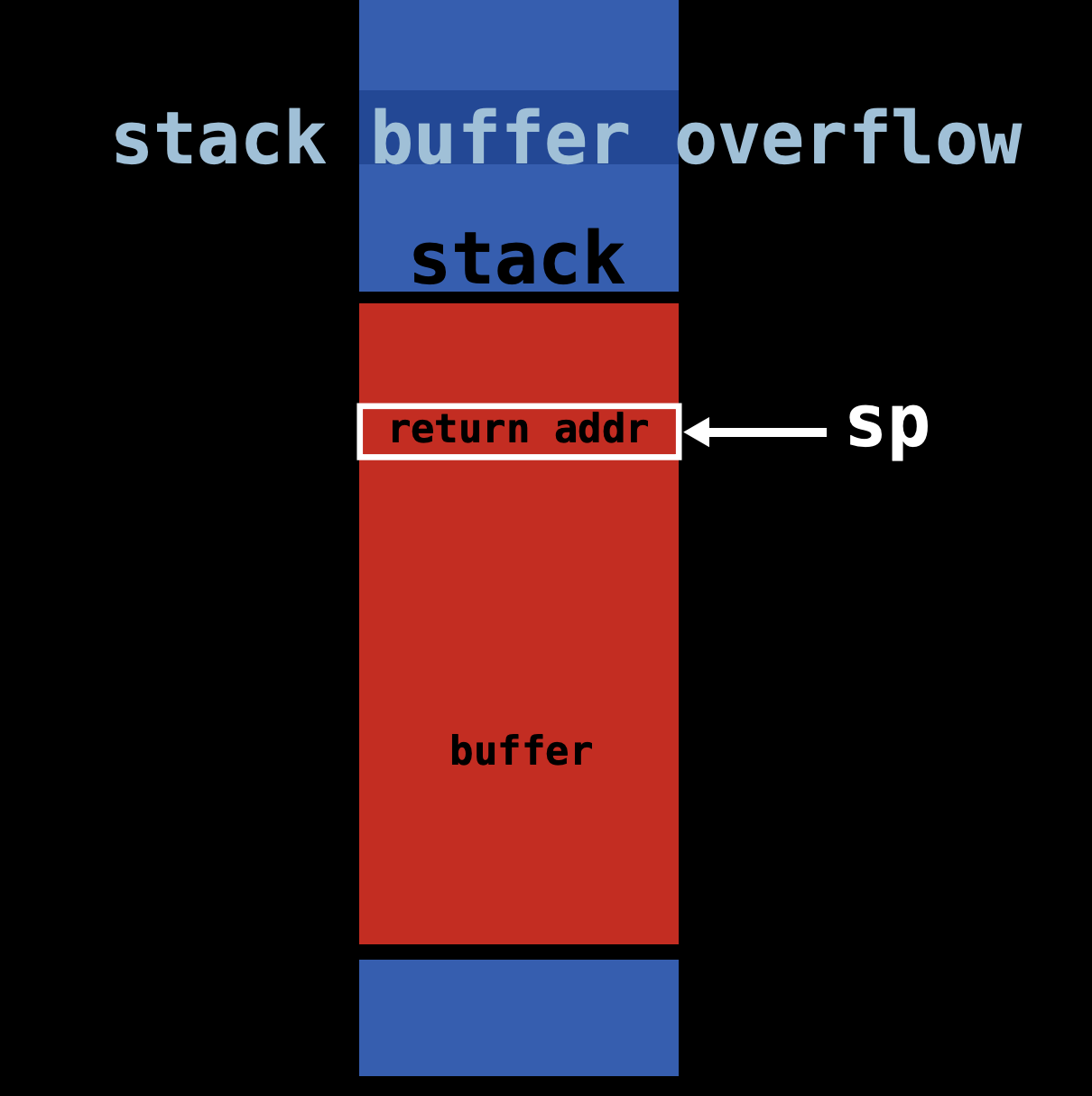
* Last. Call the Program which have a buffer overflow loophole.
and Execute it
When overflow. The return addr is addr1. and the
Kernel will execute addr1 code in memory and so on
automatically.

That makes the attacker can
run his attack code in target computer
Although it will works sometimes. But ASLR makes this work
harder.
And for an attacker, he needs to carefully
construct a large number of gadgets separately to attack each different
application, which also makes the reusability of ROP very poor.
2. Sigreturn Oriented Programming Attack
Here sigreturn is a system call, it will be
called indirectly when a signal occurs in the unix system
Before starting to introduce the attack principle of SROP. Let’s
introduce signal. Which is a system call in Unix-like
system:
Signal in Unix-like System
Signal handling has been an integral part of UNIX (and
UNIX-like) systems ever since the very first implementation by Dennis
Ritchie in the early 1970s. > Signals are an
extremely powerful mechanism to deliver asynchronous notifications
directly to a process or thread. They are used to kill processes, to
tell them that timers have expired, or to notify them about exceptional
behavior. The UNIX design has spawned a plethora of UNIX-like “children”
of which GNU Linux, several flavours of BSD, Android, iOS/Mac OS X, and
Solaris are perhaps the best known ones in active use today. While each
flavor handles signals in slightly different ways, the different
implementations are all very similar.
- As shown in the figure below, when the kernel delivers a
signal to a process, the process will be temporarily suspended and enter
the kernel(1)

- Then the kernel saves the corresponding context for the
process and jumps to the previously registered signal handler to process
the corresponding signal(2)
- When the signal handler returns (3), the kernel restores the
previously saved context for the process
- The execution of the final recovery process
(4)
In the four-step process, the third step is the
key:
How to make the signal handler in user mode
return to the kernel mode smoothly after execution?
In various UNIX-like systems, this process is slightly
different, but the general process is the same. Here is an example of
Linux:
In the second step, the kernel will help the user process
save its context on the stack of the process
Then
fill in an address rt_sigreturn at the top of the stack,
this address points to a piece of code, in which the
sigreturn system call will be called.
That means After Step 3 signal hander finished. The Stack
Pointer(%rsp) point to rt_sigreturn and Execute that code
passively
The following figure shows the user process context, signal
related information, and rt_sigreturn saved on the
stack:
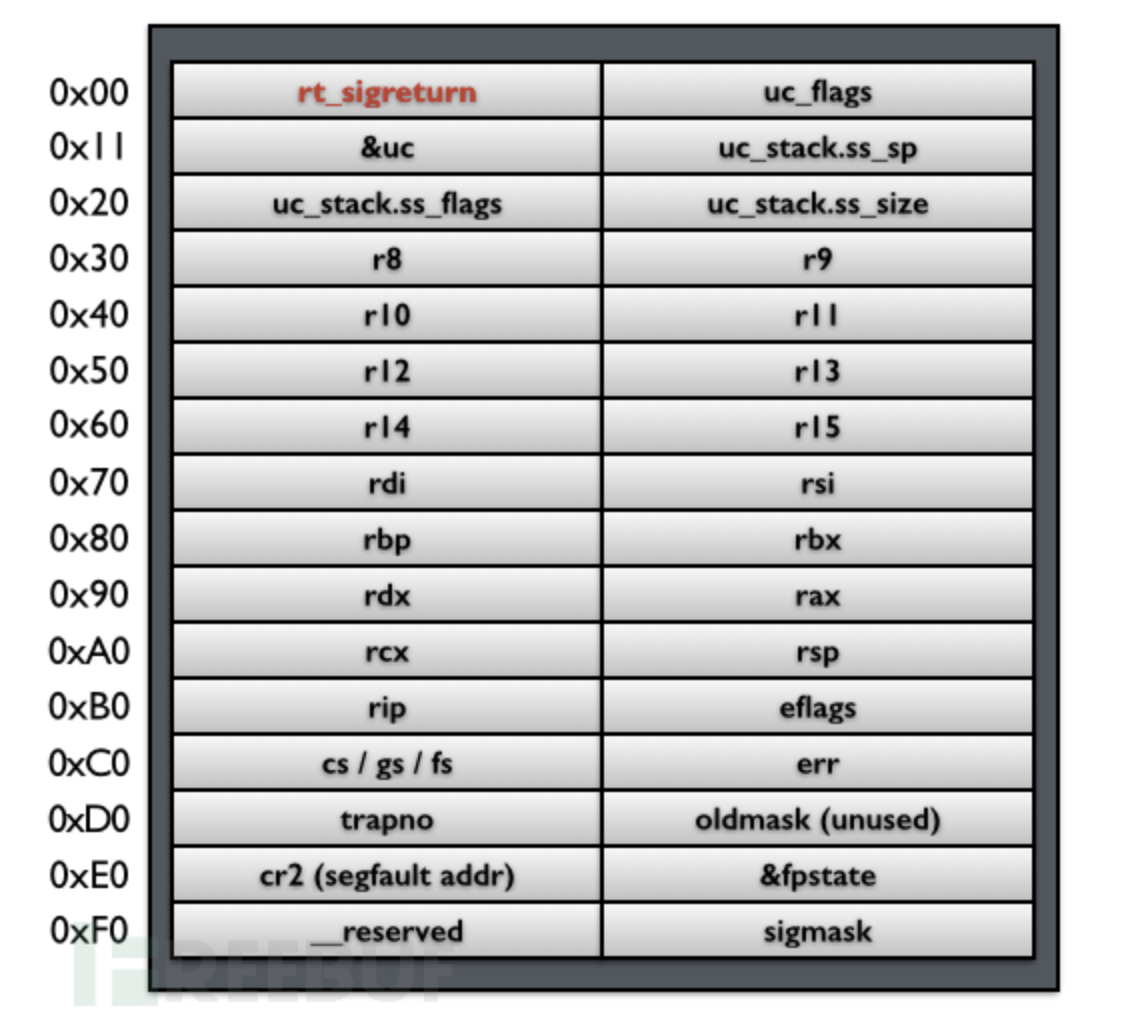
We called this: Signal
Frame
In the kernel sigreturn system
call processing function, the process context will be restored according
to the Signal Frame pointed to by the current stack
pointer, and return to the user state, and resume execution from the
suspension point.
Signal Mechanism Defect Utilization
From the Introduction below We can find two
Defects:
* Signal Frame is stored in
the address space of the user process and is readable and writable by
the user process * The kernel does not compare the
saving process with the recovery process. The kernel does not judge that
the current Signal Frame is the Signal Frame
saved by the kernel for the user process.

To Some Extent, “kernel agnostic about signal handlers” is
both an advantage and disadvantage:
The advantage
is that Because the kernel does not need to spend energy to record the
signal, and the disadvantage is that Because we can’t fake them. A
malicious user process can forge it!
Example: One of the Simplest Attacks
Let us first assume that an attacker can control the stack of
the user process, then it can forge a Signal Frame, as
shown in the figure below:
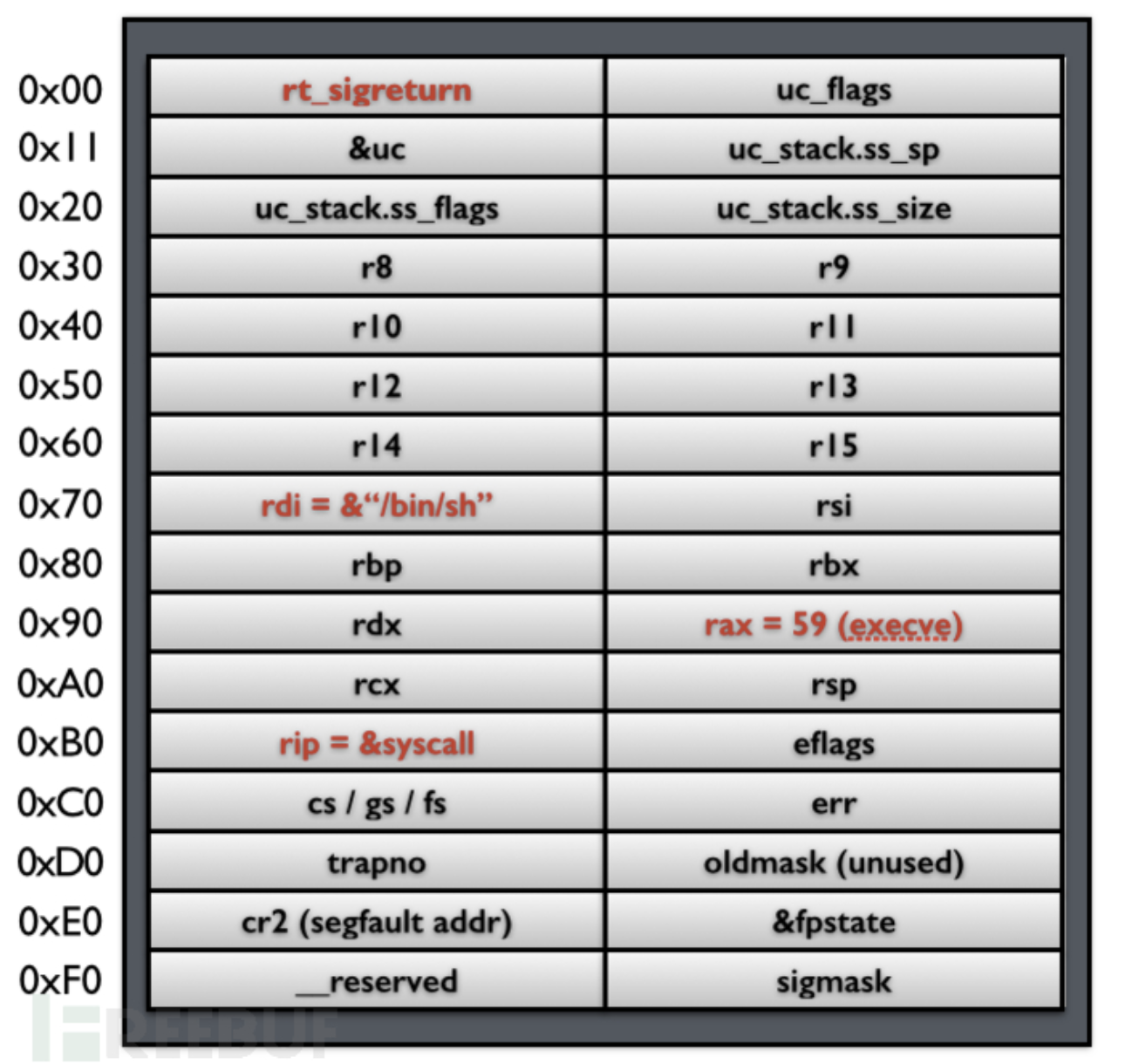 *
In this fake
*
In this fake Signal Frame, set %rax to
59 (the execve system call number) * Set
rdi to the address of the string
/bin/sh * Set rip to the
memory address of the system call instruction
syscall * Set rt_sigreturn
manually to the memory address of the sigreturn system
call
In this example, once sigreturn returns, it will
execute the execve system call and open a shell.
This is the simplest attack. In this attack, there are 4
prerequisites:
* Attackers can control the contents
of the stack through vulnerabilities such as stack buffer
overflow * Know the address of the stack (for example,
you need to know the address of the string /bin/sh you
constructed) * Know the address of the
syscall instruction in memory * Know the
memory address of the sigreturn system call
Compared with traditional ROP, this simplest SROP attack only
needs to find two gadgets. Seems more easier
System Call Chains
The Simple Attack below Worked! But the effect produced by
the attacker can only call a syscall. When the syscall returns, the
control of the execution flow is lost, which obviously cannot meet most
of the requirements.
So, how do we use the above mechanism to make system calls
continuously? In fact, the method is very simple. In addition to the
above steps, you only need to add an additional control to the stack
pointer rsp, as shown in the following
figure:
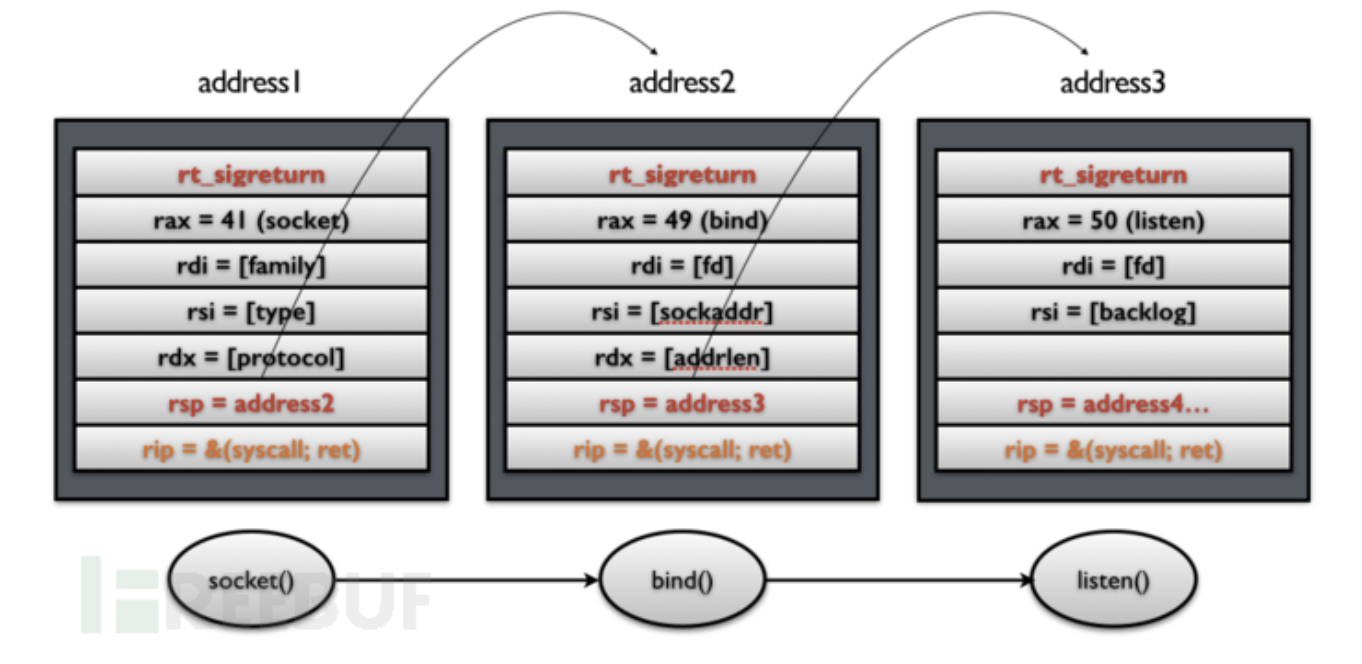 In
addition, we need to replace the original simple
In
addition, we need to replace the original simple syscall
gadget with syscall; ret gadget so that every time
syscall returns, the stack pointer will point to the next
Signal Frame.
Therefore, when the
ret instruction is executed at this time, the
sigreturn system call will be called again. In this way,
the effect of continuous system calls can be achieved by operating the
stack.
Two Gadgets
Another difference with normal ROP is that both of the two
gadgets that SROP needed can be found in a specific location in
memory:
* Sigreturn
Because Normal applications will not actively call it. The
kernel fills the corresponding address on the stack, making the
application process passively call.
Therefore,
there is usually a piece of code in the system dedicated to calling
sigreturn, The author of the paper found that in different
UNIX-like systems, this code will appear in different locations, as
shown in the following figure:
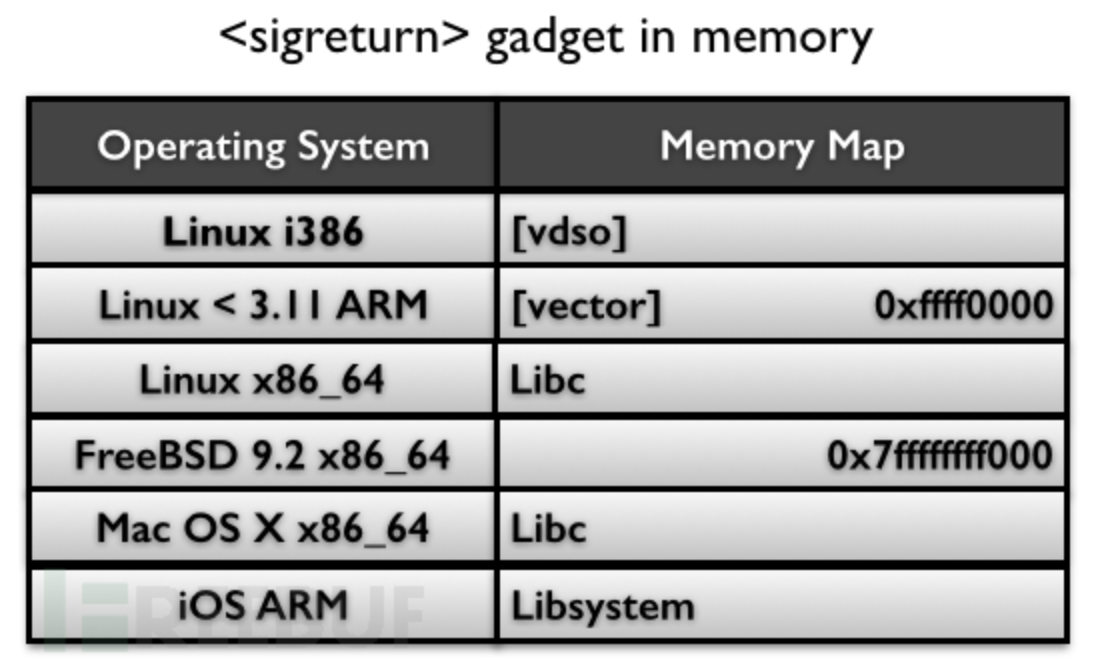
> Among
them, in Linux <3.11 ARM (the kernel used by most of
Android), and FreeBSB 9.2 x86_64, this gadget can be found
in a fixed memory address, while in other systems, it is generally
stored in In the memory of the libc library, it seems that
it is not so easy to find if it is protected by ASLR.
syscall; ret
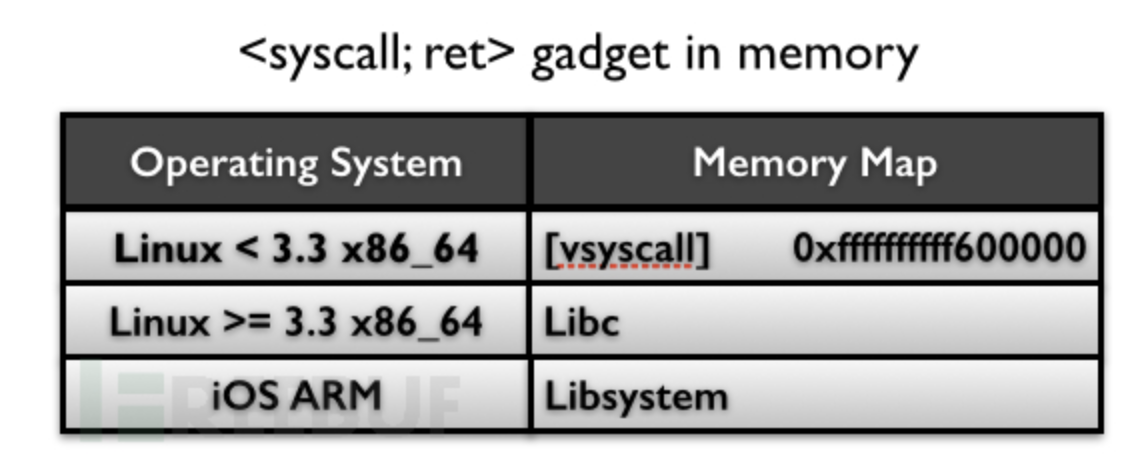 If it is Linux
<3.3 x86_64 (the default kernel in Debian 7.0, Ubuntu long-term
support, CentOS 6 system). You can find this code snippet directly in
the fixed address [vsyscall].
If it is Linux
<3.3 x86_64 (the default kernel in Debian 7.0, Ubuntu long-term
support, CentOS 6 system). You can find this code snippet directly in
the fixed address [vsyscall].
In addition to the two gadgets mentioned above that may exist at fixed addresses, in other systems, these two gadgets seem to be not so easy to find, especially in systems with ALSR protection.
However, if we compare it with traditional ROP, we can find
that it reduces the cost of the entire attack by a notch.
> SROP is among the lowest hanging fruit available to an
attacker!
3. The Prevention of SROP Attack
Finally, let’s mention the prevention of SROP. From three
perspectives, the author proposes three methods:
1.Gadgets Prevention
In the notes above We metioned that The two gadgets
sigreturn and syscall; ret are very easy to
find, especially in the presence of a particularly insecure mechanism
like vsyscall. Therefore, we should try to avoid this
mechanism and make the best use of protection mechanisms such as ASLR,
making it difficult for attackers to find these
gadgets.
Of course, this method does not essentially solve the problem
of SROP
2.Signal Frame Canaries
As we metioned that before. Borrowing from stack
canaries mechanism (Also see my
Note)
Insert a randomly generated byte before
the rt_sigreturn field of the Signal Frame. If
an overflow occurs, the byte will be destroyed, so that it will be
detected before the sigreturn occurs.
Of course, there are many attacks against stack canaries, which
also cannot essentially prevent the occurrence of SROP.
3.Break Kernel Agnostic
This will go back to the essence of SROP – Unknowability of
the Kernel to Signal
If we judge whether the
current Signal Frame was created before the kernel when the
kernel processes the sigreturn system call, then this
problem can be fundamentally solved. Of course, this involves modifying
some of the underlying design of the kernel, and it may also introduce
some new problems.